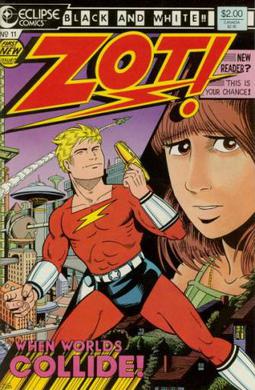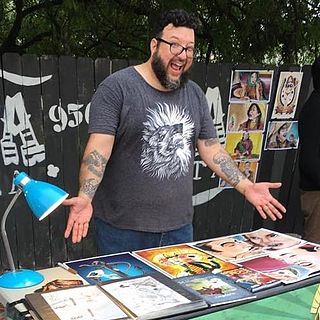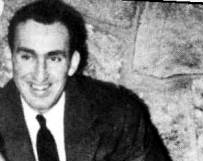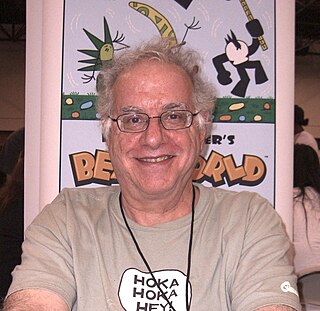Related Research Articles

A comic strip is a sequence of cartoons, arranged in interrelated panels to display brief humor or form a narrative, often serialized, with text in balloons and captions. Traditionally, throughout the 20th and into the 21st century, these have been published in newspapers and magazines, with daily horizontal strips printed in black-and-white in newspapers, while Sunday papers offered longer sequences in special color comics sections. With the advent of the internet, online comic strips began to appear as webcomics.

A graphic novel is a long-form, fictional work of sequential art. The term graphic novel is often applied broadly, including fiction, non-fiction, and anthologized work, though this practice is highly contested by comics scholars and industry professionals. It is, at least in the United States, typically distinct from the term comic book, which is generally used for comics periodicals and trade paperbacks.

Scott McCloud is an American cartoonist and comics theorist. He is best known for his non-fiction books about comics: Understanding Comics (1993), Reinventing Comics (2000), and Making Comics (2006), all of which also use the medium of comics.
A minicomic is a creator-published comic book, often photocopied and stapled or with a handmade binding. In the United Kingdom and Europe the term small press comic is equivalent with minicomic, reserved for those publications measuring A6 or less.

Milton Arthur Paul Caniff was an American cartoonist famous for the Terry and the Pirates and Steve Canyon comic strips.
Serializer.net was a webcomic subscription service and artist collective published by Joey Manley and edited by Tom Hart and Eric Millikin that existed from 2002 to 2013. Designed to showcase artistic alternative webcomics using the unique nature of the medium, the works on Serializer.net were described by critics as "high art" and "avant-garde". The project became mostly inactive in 2007 and closed alongside Manley's other websites in 2013.
Danny Hellman is an American freelance illustrator and cartoonist. Since 1989, his illustrations have appeared in publications including Time, Fortune, Sports Illustrated, The Wall Street Journal and others, and his comic book work has appeared in DC Comics publications.

Zot! is a comic book created by Scott McCloud in 1984 and published by Eclipse Comics until 1990 as a lighthearted alternative to the darker and more violent comics that dominated the industry during that period. There were a total of 36 issues, with the first ten in color and the remainder in black and white.

Cayetano 'Cat' Garza is a comic artist, cartoonist, illustrator, and musician in the United States. He is best known for his experiments with webcomics.

Too Much Coffee Man (TMCM) is an American satirical superhero created by cartoonist Shannon Wheeler. Too Much Coffee Man wears what appears to be a spandex version of old-fashioned red "long johns" with a large mug attached atop his head. He is an anxious Everyman who broods about the state of the world, from politics to people, exchanging thoughts with friends and readers.

Douglas S. Wildey was an American cartoonist and comic book artist best known for creating the 1964 animated television series Jonny Quest for Hanna-Barbera Productions.

Terry LaBan is an alternative/underground cartoonist and newspaper comic strip artist. He is known for his comic book series Cud, and his syndicated strip Edge City, created with his wife, Patty LaBan, a couples and family therapist.
Paul Leroy Norris was an American comic book artist best known as co-creator of the DC Comics superhero Aquaman, and for a 35-year run as artist of the newspaper comic strip Brick Bradford.

Creig Valentine Flessel was an American comic book artist and an illustrator and cartoonist for magazines ranging from Boys' Life to Playboy. One of the earliest comic book illustrators, he was a 2006 nominee for induction into the comics industry's Will Eisner Hall of Fame.

Marc Hansen is a cartoonist and creator of Ralph Snart, Weird Melvin and Doctor Gorpon. He has been published by comic book companies such as NOW Comics, Marvel/Epic, Disney, Malibu Graphics and Kitchen Sink Press. Ralph Snart is his most successful creation that began in 1986, which had newsstand and direct market distribution. It peaked at 50,000 copies per month with over one million comics in print.

Larry Marder is an American cartoonist and writer, best known as the creator of comic book Tales of the Beanworld, which began as an "essentially self-published title" in 1984. Beginning in 2009, Dark Horse Books began to reprint Tales of the Beanworld, in two volumes, and then went on to publish two more volumes of new Beanworld.

Kevin Huizenga is an American cartoonist, best known as the creator of the comics character Glenn Ganges, who appears in most of his work.
The Amazing Spider-Man is a daily comic strip featuring the character Spider-Man which has been syndicated for more than 40 years. It is a dramatic, soap opera-style strip with story arcs which typically run for 8 to 12 weeks. While the strip uses many of the same characters as the Spider-Man comic book, the storylines are nearly all originals and do not share the same continuity. A consistently popular strip, new material was published from 1977 to 2019, with the strip going into reruns afterwards.
The Masters of the Universe media franchise has appeared in several comic book series. Most were small publications, which were included as bonuses with action figures. Standalone comic-book series were also published by DC, Marvel Comics, London Edition Magazines and Image Comics.

Michael DeForge is a Canadian comics artist and illustrator.
References
- 1 2 3 4 5 Feazell entry. Who's Who of American Comic Books, 1928–1999. Accessed March 28, 2016.
- 1 2 3 4 Jiompkowski, Michelle O. (2003-03-05). "Cartoonist creates dizzy adventures for the young". The Detroit News .
- 1 2 3 Feazell entry, Lambiek's Comiclopedia. Accessed March 28, 2016.